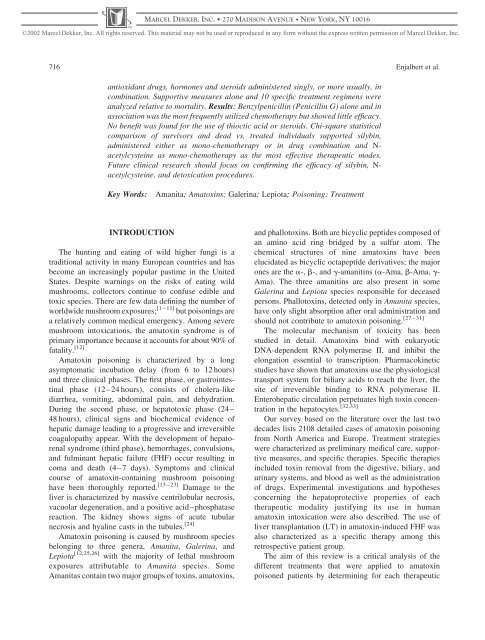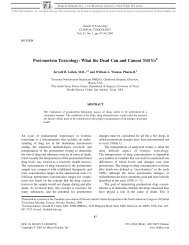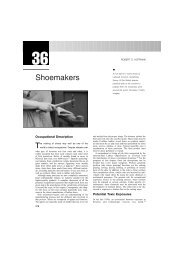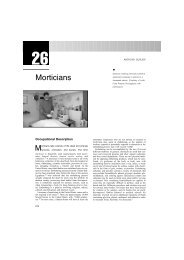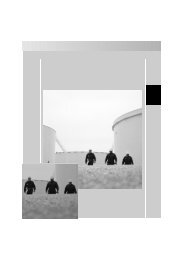9. Treatment of Amatoxin Poisoning-20 year retrospective analysis
9. Treatment of Amatoxin Poisoning-20 year retrospective analysis
9. Treatment of Amatoxin Poisoning-20 year retrospective analysis
Create successful ePaper yourself
Turn your PDF publications into a flip-book with our unique Google optimized e-Paper software.
716<br />
antioxidant drugs, hormones and steroids administered singly, or more usually, in<br />
combination. Supportive measures alone and 10 specific treatment regimens were<br />
analyzed relative to mortality. Results: Benzylpenicillin (Penicillin G) alone and in<br />
association was the most frequently utilized chemotherapy but showed little efficacy.<br />
No benefit was found for the use <strong>of</strong> thioctic acid or steroids. Chi-square statistical<br />
comparison <strong>of</strong> survivors and dead vs. treated individuals supported silybin,<br />
administered either as mono-chemotherapy or in drug combination and Nacetylcysteine<br />
as mono-chemotherapy as the most effective therapeutic modes.<br />
Future clinical research should focus on confirming the efficacy <strong>of</strong> silybin, Nacetylcysteine,<br />
and detoxication procedures.<br />
Key Words: Amanita; <strong>Amatoxin</strong>s; Galerina; Lepiota; <strong>Poisoning</strong>; <strong>Treatment</strong><br />
INTRODUCTION<br />
The hunting and eating <strong>of</strong> wild higher fungi is a<br />
traditional activity in many European countries and has<br />
become an increasingly popular pastime in the United<br />
States. Despite warnings on the risks <strong>of</strong> eating wild<br />
mushrooms, collectors continue to confuse edible and<br />
toxic species. There are few data defining the number <strong>of</strong><br />
worldwide mushroom exposures; [1 – 11] but poisonings are<br />
a relatively common medical emergency. Among severe<br />
mushroom intoxications, the amatoxin syndrome is <strong>of</strong><br />
primary importance because it accounts for about 90% <strong>of</strong><br />
fatality. [12]<br />
<strong>Amatoxin</strong> poisoning is characterized by a long<br />
asymptomatic incubation delay (from 6 to 12 hours)<br />
and three clinical phases. The first phase, or gastrointestinal<br />
phase (12–24 hours), consists <strong>of</strong> cholera-like<br />
diarrhea, vomiting, abdominal pain, and dehydration.<br />
During the second phase, or hepatotoxic phase (24–<br />
48 hours), clinical signs and biochemical evidence <strong>of</strong><br />
hepatic damage leading to a progressive and irreversible<br />
coagulopathy appear. With the development <strong>of</strong> hepatorenal<br />
syndrome (third phase), hemorrhages, convulsions,<br />
and fulminant hepatic failure (FHF) occur resulting in<br />
coma and death (4–7 days). Symptoms and clinical<br />
course <strong>of</strong> amatoxin-containing mushroom poisoning<br />
have been thoroughly reported. [13 – 23] Damage to the<br />
liver is characterized by massive centrilobular necrosis,<br />
vacuolar degeneration, and a positive acid–phosphatase<br />
reaction. The kidney shows signs <strong>of</strong> acute tubular<br />
necrosis and hyaline casts in the tubules. [24]<br />
<strong>Amatoxin</strong> poisoning is caused by mushroom species<br />
belonging to three genera, Amanita, Galerina, and<br />
Lepiota [12,25,26] with the majority <strong>of</strong> lethal mushroom<br />
exposures attributable to Amanita species. Some<br />
Amanitas contain two major groups <strong>of</strong> toxins, amatoxins,<br />
MARCEL DEKKER, INC. 270 MADISON AVENUE NEW YORK, NY 10016<br />
©<strong>20</strong>02 Marcel Dekker, Inc. All rights reserved. This material may not be used or reproduced in any form without the express written permission <strong>of</strong> Marcel Dekker, Inc.<br />
and phallotoxins. Both are bicyclic peptides composed <strong>of</strong><br />
an amino acid ring bridged by a sulfur atom. The<br />
chemical structures <strong>of</strong> nine amatoxins have been<br />
elucidated as bicyclic octapeptide derivatives; the major<br />
ones are the a-, b-, and g-amanitins (a-Ama, b-Ama, g-<br />
Ama). The three amanitins are also present in some<br />
Galerina and Lepiota species responsible for deceased<br />
persons. Phallotoxins, detected only in Amanita species,<br />
have only slight absorption after oral administration and<br />
should not contribute to amatoxin poisoning.<br />
Enjalbert et al.<br />
[27 – 31]<br />
The molecular mechanism <strong>of</strong> toxicity has been<br />
studied in detail. <strong>Amatoxin</strong>s bind with eukaryotic<br />
DNA-dependent RNA polymerase II, and inhibit the<br />
elongation essential to transcription. Pharmacokinetic<br />
studies have shown that amatoxins use the physiological<br />
transport system for biliary acids to reach the liver, the<br />
site <strong>of</strong> irreversible binding to RNA polymerase II.<br />
Enterohepatic circulation perpetuates high toxin concentration<br />
in the hepatocytes. [32,33]<br />
Our survey based on the literature over the last two<br />
decades lists 2108 detailed cases <strong>of</strong> amatoxin poisoning<br />
from North America and Europe. <strong>Treatment</strong> strategies<br />
were characterized as preliminary medical care, supportive<br />
measures, and specific therapies. Specific therapies<br />
included toxin removal from the digestive, biliary, and<br />
urinary systems, and blood as well as the administration<br />
<strong>of</strong> drugs. Experimental investigations and hypotheses<br />
concerning the hepatoprotective properties <strong>of</strong> each<br />
therapeutic modality justifying its use in human<br />
amatoxin intoxication were also described. The use <strong>of</strong><br />
liver transplantation (LT) in amatoxin-induced FHF was<br />
also characterized as a specific therapy among this<br />
<strong>retrospective</strong> patient group.<br />
The aim <strong>of</strong> this review is a critical <strong>analysis</strong> <strong>of</strong> the<br />
different treatments that were applied to amatoxin<br />
poisoned patients by determining for each therapeutic


